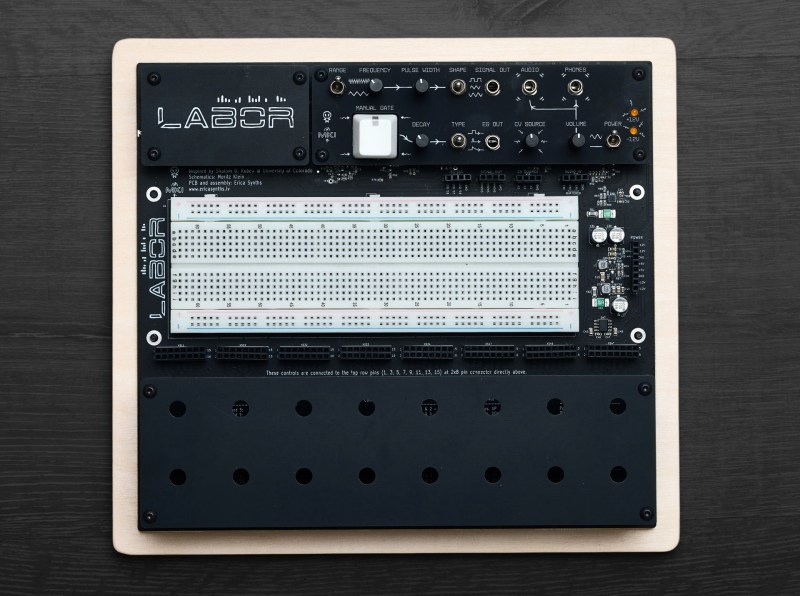Synth designers [Erica Synths] have devised a very cool, approachable way to get started with DIY synth hacking. Designed around a breadboard, the EDU DIY LABOR is a synth module with everything you need to get started. The Basic version comes with potentiometers, switches, and jack sockets, and is aimed more at those who likely already have a decent supply of parts on hand for experimentation. The Full kit comes with all that, plus a supply of resistors, capacitors, ICs and transistors so you can get up to speed, even as a beginner.
The device is supplied as a semi-DIY kit, with some soldering and assembly required. The kit was designed in collaboration with Dr. Shalom D. Ruben, a teaching professor of engineering at the University of Colorado. So it should be approachable for those with some soldering experience under their belt. Labor includes a multi-voltage power supply which supplies all Eurorack voltages, an oscillator section for both audible ranges and LFO, a full envelope control section, an output amplifier and more! Once assembled you can quickly start making bloops, beeps, and bzzts. You can easily design filters, oscillators, amplifiers, sequencers, and whatever else you can dream up!
However, the kit is designed to be more than just a synth playground – the idea was also to create an environment where you could learn the basics of electronics at the same time, in an approachable, fun way. This is reflected in the excellent user manual, which goes beyond just assembling the device and gives some example circuits, complete with wave diagrams and detailed working explanations. Great for beginners and experienced hackers who want to learn more about fundamentals and audio synthesis!















I have a Hive Mind Synthesis Pixie Dance Floor. Which is a DIY kit that gets a solderless breadboard onto a euroack module. It gets you some buttons and knobs and jacks, and makes it easy to build up a small circuit that is CV controlled, or one that can output CV or audio.
That’s a nice kit to play around with too. You could plug in a daisy seed synth and have a whole lot of fun playing around.
Checkout the Mocrorack synth too, I think many people here might like it!
“Requires soldering”. If you can already solder, that removes one of the main “advantages” of solderless breadboards, plus you can move directly to using the much better “manhattan” prototyping techniques.
But I suppose using a solderless breadboard will give beginners useful experience in debugging intermittent problems related to varying contact resistances[1], and unpredictable problems related to “stray” capacitances[2] and inductances.
[1] especially fun if they are part of a sub-circuit setting a PSU voltage
[2] as discussed in TAoE x-chapters 2x.10 p138
I have to disagree, at least a bit. The soldering required for this kit is fairly minimal. And I would consider myself an expert level solderer, but I still get a lot of use out of breadboards when quickly prototyping something or if I just want to temporarily connect debug probes to a chip, etc. It saves time and also helps work out any mistakes before making something permanent.
IMNSHO solderless breadboards cause as many problems as they solve.
I like debugging my circuit’s function and operation. I dislike spending time debugging substandard implementation technology – when there are easy cheap simple *better* alternatives.
For example?
List these easy cheap simple better alternatives.
Several are shown here
https://entertaininghacks.wordpress.com/2020/07/22/prototyping-circuits-easy-cheap-fast-reliable-techniques/
In practice it normal to select the subset relevant to the job at hand.
(The “For example?” response is ambiguous)
@Tom G these suggestions are all great, but none of them replace the primary uses for breadboards, testing and initial prototyping.
its important to remember that this isnt really for true beginners. it’s to help design synth components which is definitely a few steps up.
if you are spending money on a synth prototyping board then you have most likely done a few electronic things before, potentially even the other erica/mki educational kits.
This seems mainly like a thing that MKI made for himself and his needs and thought that probably someone else would want it too.